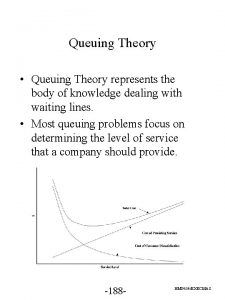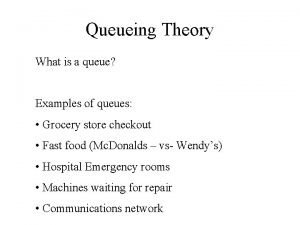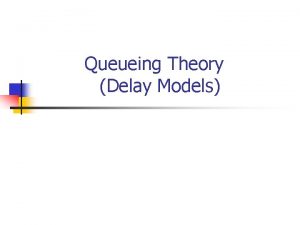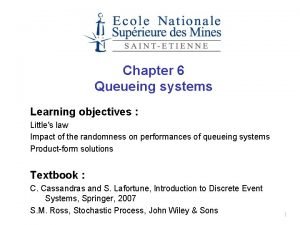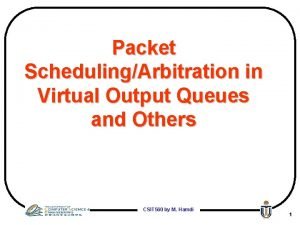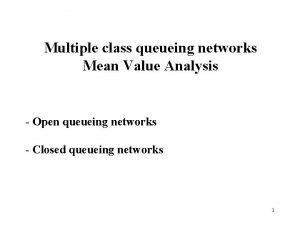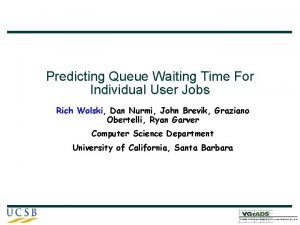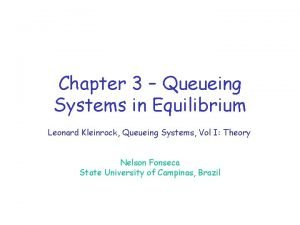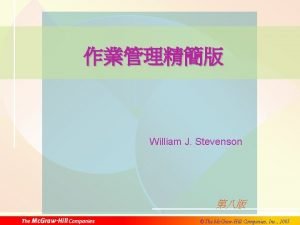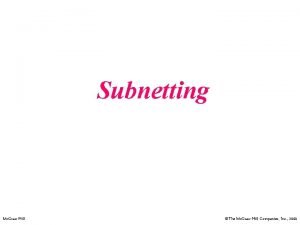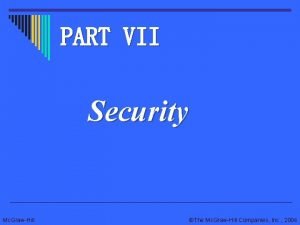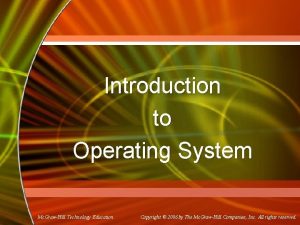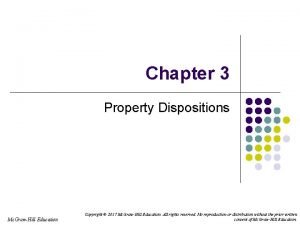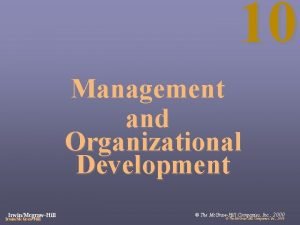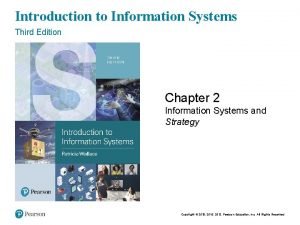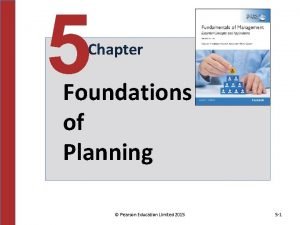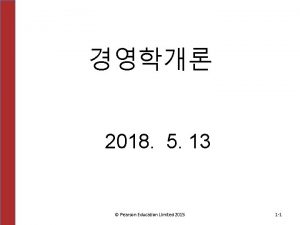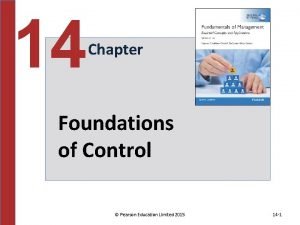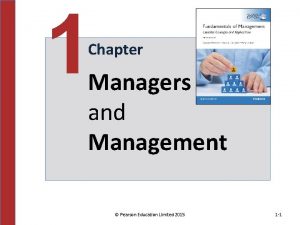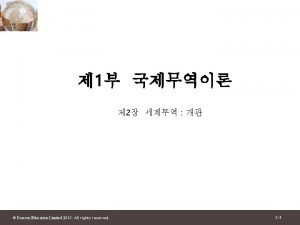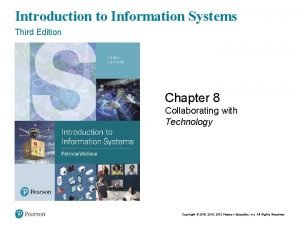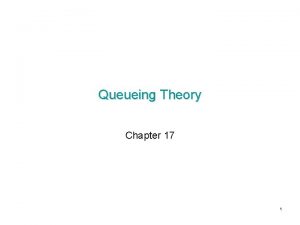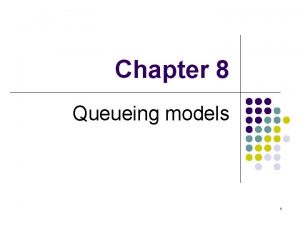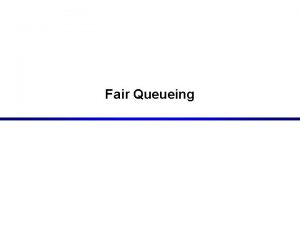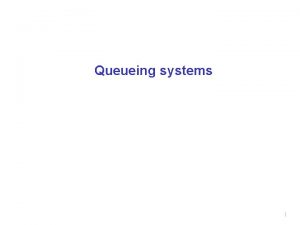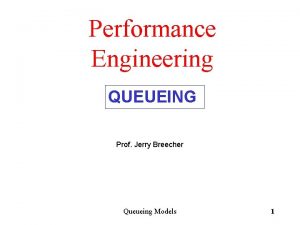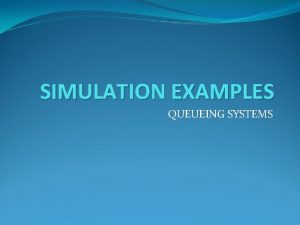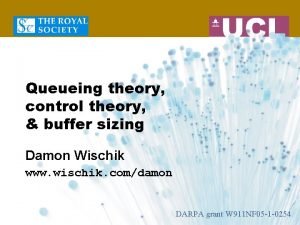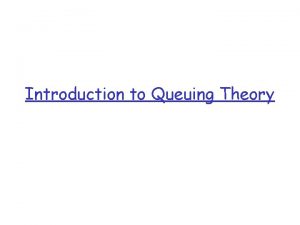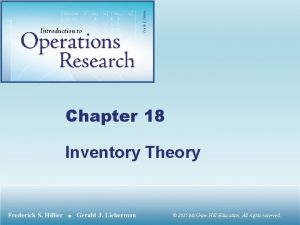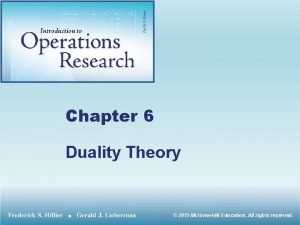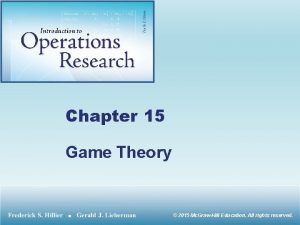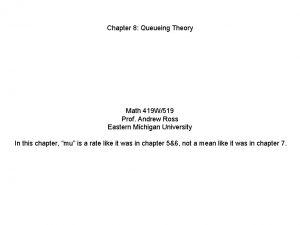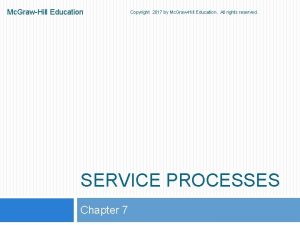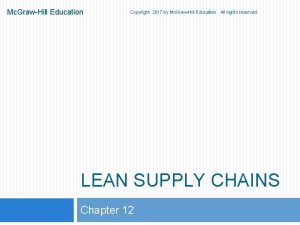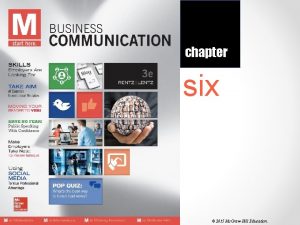Chapter 17 Queueing Theory 2015 Mc GrawHill Education



































- Slides: 35

Chapter 17 Queueing Theory © 2015 Mc. Graw-Hill Education. All rights reserved.

Introduction • Queues (waiting lines) are part of everyday life, and an inefficient use of time • Other types of inefficiencies – Machines waiting to be repaired – Ships waiting to be unloaded – Airplanes waiting to take off or land • Queueing models – Determine how to operate a queueing system most efficiently © 2015 Mc. Graw-Hill Education. All rights reserved. 2

17. 1 Prototype Example • Emergency room at County Hospital is experiencing an increase in the number of visits – Patients are at peak usage hours often have to wait – One doctor is on duty at all times – Proposal: add another doctor – Hospital’s management engineer is assigned to study the proposal • Will use queueing theory models © 2015 Mc. Graw-Hill Education. All rights reserved. 3

17. 2 Basic Structure of Queueing Models • Basic queueing process – Customers requiring service are generated over time by an input source – Customers enter a queueing system and join a queue if service not immediately available – Queue discipline rule is used to select a member of the queue for service – Service is performed by the service mechanism – Customer leaves the queueing system © 2015 Mc. Graw-Hill Education. All rights reserved. 4

Basic Structure of Queueing Models • Calling population – Population from which arrivals come – Size may be assumed to be infinite or finite • Calculations are far easier for infinite case • Statistical pattern by which customers are generated over time must be specified – Common assumption: Poisson process • Interarrival time – Time between consecutive arrivals © 2015 Mc. Graw-Hill Education. All rights reserved. 5

Basic Structure of Queueing Models • Balking – Customer refuses to enter queue if it is too long • Queue is characterized by the number of members it can contain – Can be infinite or finite • Infinite is the standard assumption for most models • Queue discipline examples – First-come-first-served, random, or other © 2015 Mc. Graw-Hill Education. All rights reserved. 6

Basic Structure of Queueing Models • Service mechanism – Parallel service channels are called servers • Service time (holding time) – Time for service to be completed – Exponential distribution is frequently assumed in practice © 2015 Mc. Graw-Hill Education. All rights reserved. 7

Basic Structure of Queueing Models © 2015 Mc. Graw-Hill Education. All rights reserved. 8

Basic Structure of Queueing Models • Model notation example – M/M/s • First letter refers to distribution of interarrival times • Second letter indicates distribution of service times • Third letter indicates number of servers • M: exponential distribution • D: degenerate distribution • Ek: Erlang distribution • G: general distribution (any arbitrary distribution allowed) © 2015 Mc. Graw-Hill Education. All rights reserved. 9

Basic Structure of Queueing Models • Transient condition of a queue – Condition when a queue has recently begun operation • Steady-state condition of a queue – Independent of initial state and elapsed time © 2015 Mc. Graw-Hill Education. All rights reserved. 10

Basic Structure of Queueing Models • © 2015 Mc. Graw-Hill Education. All rights reserved. 11

17. 3 Examples of Real Queueing Systems • Classes of queueing systems – Commercial service systems • Example: barbershop – Transportation service systems • Example: cars waiting at a tollbooth – Internal service systems • Customers are internal to the organization – Social service systems • Example: judicial system © 2015 Mc. Graw-Hill Education. All rights reserved. 12

17. 4 The Role of the Exponential Distribution • Operating characteristics of queueing systems determined by: – Probability distribution of interarrival times – Probability distribution of service times • Negative values cannot occur in the probability distributions • Exponential distribution – Meets goals of realistic, reasonable, simple, and mathematically tractable © 2015 Mc. Graw-Hill Education. All rights reserved. 13

The Role of the Exponential Distribution • Key properties of the exponential distribution – f. T(t) is a strictly decreasing function of t © 2015 Mc. Graw-Hill Education. All rights reserved. 14

The Role of the Exponential Distribution • Key properties of the exponential distribution – Lack of memory • Probability distribution of remaining time until event is always the same – The minimum of several independent exponential random variables has an exponential distribution – A relationship exists with the Poisson distribution © 2015 Mc. Graw-Hill Education. All rights reserved. 15

The Role of the Exponential Distribution • © 2015 Mc. Graw-Hill Education. All rights reserved. 16

17. 5 The Birth-and-Death Process • Birth – Arrival of a new customer into the queueing system • Death – Departure of a served customer • Birth-and-death process – Describes how the number of customers in the queueing system changes as t increases © 2015 Mc. Graw-Hill Education. All rights reserved. 17

The Birth-and-Death Process • Individual births and deaths occur randomly – Lack of memory is characteristic of a Markov chain • Arrows in the diagram indicate possible transitions in the state of the system © 2015 Mc. Graw-Hill Education. All rights reserved. 18

The Birth-and-Death Process • Analysis is very difficult if the system is in a transient condition – Straightforward if a steady state condition exists • For any state of the system: – Mean entering rate equals mean leaving rate • Called the balance equation for state n © 2015 Mc. Graw-Hill Education. All rights reserved. 19

The Birth-and-Death Process • Key measures of performance for the queueing system © 2015 Mc. Graw-Hill Education. All rights reserved. 20

17. 6 Queueing Models Based on the Birthand-Death Process • Models have a Poisson input and exponential service times • The M/M/s model © 2015 Mc. Graw-Hill Education. All rights reserved. 21

Queueing Models Based on the Birth-and. Death Process • The M/M/s model as applied to the County Hospital example – See Pages 755 -757 in the text • The finite queue variation of the M/M/s model – Called the M/M/s/K model – Queue capacity is equal to (K − s) © 2015 Mc. Graw-Hill Education. All rights reserved. 22

Queueing Models Based on the Birth-and. Death Process • The finite calling population variation of the M/M/s model – Given on Pages 760 -762 of the text – See next slide for diagram © 2015 Mc. Graw-Hill Education. All rights reserved. 23

Queueing Models Based on the Birth-and. Death Process © 2015 Mc. Graw-Hill Education. All rights reserved. 24

17. 7 Queueing Models Involving Nonexponential Distributions • Poisson distribution does not apply when arrivals or service times are carefully scheduled or regulated – Mathematical analysis much more difficult • Summary of models available for nonexponential service times – The M/G/1 model – The M/D/s model – The M/Ek/s model © 2015 Mc. Graw-Hill Education. All rights reserved. 25

Queueing Models Involving Nonexponential Distributions • Summary of models available for nonexponential input distributions – The GI/M/s model – The D/M/s model – The Ek/M/s model • Other models deal with: – Hyperexponential distributions – Phase-type distributions © 2015 Mc. Graw-Hill Education. All rights reserved. 26

17. 8 Priority-Discipline Queueing Models • Queue discipline based on a priority system – Assumes N priority classes exist – Poisson input process and exponential service times are assumed for each priority class • Nonpreemptive priorities – Customer being served cannot be ejected © 2015 Mc. Graw-Hill Education. All rights reserved. 27

Priority-Discipline Queueing Models • Preemptive properties – Lowest priority customer is ejected back into the queue • Whenever higher priority customer enters queueing system • Results for the nonpreemptive priorities model – Little’s formula still applies – See Pages 771 -772 in the text © 2015 Mc. Graw-Hill Education. All rights reserved. 28

Priority-Discipline Queueing Models • Results for the preemptive priorities model – Total expected waiting time in the system changes – For the single server case: © 2015 Mc. Graw-Hill Education. All rights reserved. 29

17. 9 Queueing Networks • Only a single service facility has been considered so far – Some problems have multiple service facilities, or a queueing network • Two basic kinds of networks – Infinite queues in series – Jackson networks © 2015 Mc. Graw-Hill Education. All rights reserved. 30

Queueing Networks • Equivalence property – Assume that a service facility with s servers and an infinite queue has Poisson input with parameter λ and the same exponential service time distribution with parameter μ for each server (the M/M/s model) where s μ > λ • Steady state output of this service facility is also a Poisson process with parameter λ © 2015 Mc. Graw-Hill Education. All rights reserved. 31

17. 10 The Application of Queueing Theory • Queueing system design involves the selection of: – Number of servers at a service facility – Efficiency of the servers – Number of service facilities – Amount of waiting space in the queue – Any priorities for different categories of customers © 2015 Mc. Graw-Hill Education. All rights reserved. 32

The Application of Queueing Theory • Primary considerations in decision making – Cost of service capacity provided by the queueing system – Consequences of making customers wait in the queueing system • Approaches – Establish how much waiting time is acceptable – Determine the cost of waiting © 2015 Mc. Graw-Hill Education. All rights reserved. 33

The Application of Queueing Theory • Other issues – Waiting cost may not be proportional to amount of waiting • Might be a nonlinear function – Is it better to have a single fast server or multiple slower servers? © 2015 Mc. Graw-Hill Education. All rights reserved. 34

17. 11 Conclusions • Queueing theory provides a basis for modeling queueing systems – Goal is to achieve an appropriate balance between cost of service and cost of waiting • The exponential distribution plays a fundamental role in queueing theory • Priority-discipline queueing models – Appropriate when some categories of customers given priority over others © 2015 Mc. Graw-Hill Education. All rights reserved. 35
 Queuing theory formula
Queuing theory formula Queueing theory examples
Queueing theory examples Queuing theory examples
Queuing theory examples Little's formula queueing theory
Little's formula queueing theory Virtual output queueing
Virtual output queueing Queueing
Queueing Predictive queueing
Predictive queueing Kleinrock queueing systems
Kleinrock queueing systems Grawhill
Grawhill Grawhill
Grawhill 作業管理精簡版13版解答
作業管理精簡版13版解答 Grawhill
Grawhill Mc graw hill
Mc graw hill Single user multitasking os
Single user multitasking os Grawhill
Grawhill Mc grawhill
Mc grawhill Grawhill
Grawhill 2015 pearson education inc
2015 pearson education inc Malaysia higher education blueprint
Malaysia higher education blueprint Education for all 2000-2015: achievements and challenges
Education for all 2000-2015: achievements and challenges 2015 pearson education inc
2015 pearson education inc Pearson education limited 2015
Pearson education limited 2015 Foundations of planning
Foundations of planning 2015 pearson education inc
2015 pearson education inc 2015 pearson education inc
2015 pearson education inc Pearson education limited 2015
Pearson education limited 2015 Pearson education limited 2015
Pearson education limited 2015 Pearson education limited 2015
Pearson education limited 2015 Pearson education limited 2015
Pearson education limited 2015 2015 pearson education inc
2015 pearson education inc Pearson education limited 2015
Pearson education limited 2015 Education at a glance 2015
Education at a glance 2015 2015 pearson education inc
2015 pearson education inc Pearson education ltd 2015
Pearson education ltd 2015 2015 pearson education inc
2015 pearson education inc Pearson education limited 2015
Pearson education limited 2015
